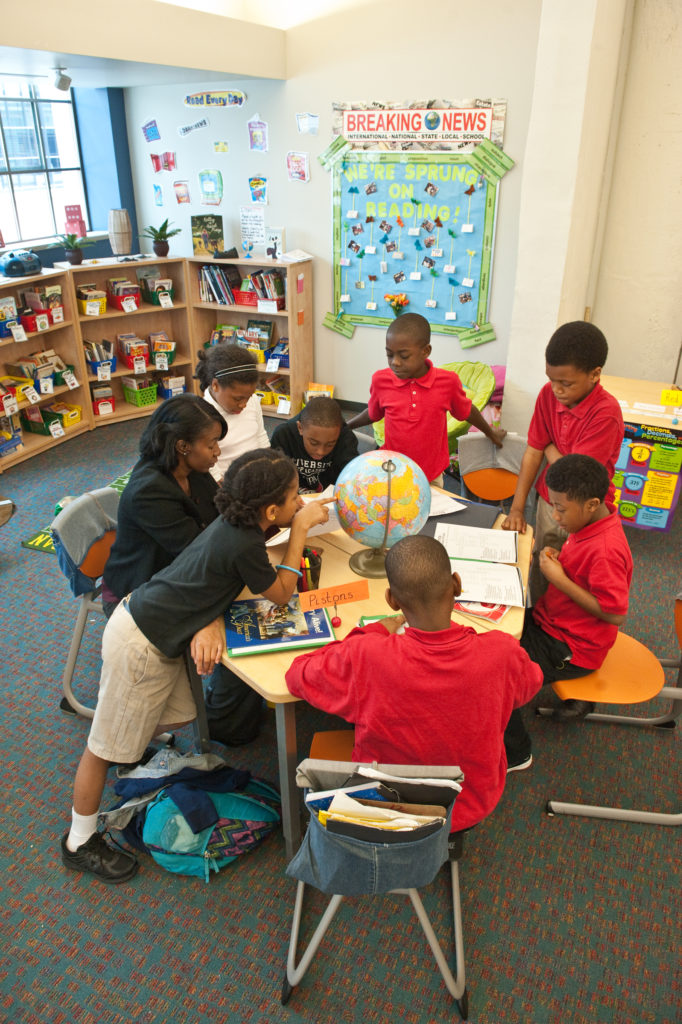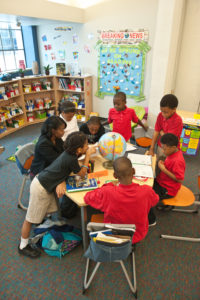
 Question: I’m concerned that the group activity portion of our Morning Meeting mostly has become a time to play games. I know it’s important for the students to have fun together, but how can I use group activities to reinforce academic skills, too?
Question: I’m concerned that the group activity portion of our Morning Meeting mostly has become a time to play games. I know it’s important for the students to have fun together, but how can I use group activities to reinforce academic skills, too?A: “Group activity is a great way to start the day,” a fifth grader recently informed me. I couldn’t agree more, but I know something about group activity that the students probably don’t know: it’s also a great way to learn. And the fact that the children and I are having fun together increases the learning.
I have two favorite activities that support academic goals: Sparkle, a spelling activity, and Buzz, a counting activity. The students demand to play Sparkle at least once a week, practicing spelling words from our weekly list. Everybody stands in a circle to play. The caller says a spelling word. The next person uses the word in a sentence. Then players go around the circle to spell the word, adding one letter at a time. If the group spells the word correctly, the person who finishes spelling it says “sparkle” to the next person in the circle. The person who gets “sparkled” gently floats into his or her chair like sparks falling from the sky. If a student makes a mistake along the way, he or she “sparkles”—and sits down—when the caller or another student notices the error. You can create many extensions to Sparkle, such as having a student name the part of speech from the second player’s sentence.
Another class favorite is Buzz. Buzz reinforces concepts of multiplication and factoring. Choose a number, for example: 2. Then begin counting around the circle. Each time a person gets a multiple of the chosen number, that person says, “Buzz,” instead of the number. You’ll be surprised by how challenging this game can be, and you’ll also have to answer questions like, “What about zero?” For additional challenge, you can extend the game into Bizz Buzz. In this game, students pay attention to multiples and factors of two different numbers. For example, if 2 and 3 are chosen, multiples of only 2 (e.g. 4, 8, 10) are replaced by “Bizz,” multiples of only 3 (e.g. 9, 15, 21) are replaced by “Buzz,” and multiples of both 2 and 3 (e.g., 6, 12, 18) are replaced by “Bizz Buzz.” Just try this with fourth and fifth graders!
Eric Henry teaches fifth grade at John Middleton Elementary School in Skokie, Illinois, a suburb of Chicago. Eric has been implementing the Responsive Classroom approach for seven years and is a certified Responsive Classroom consulting teacher.
A: First, to emphasize for students that group activities are more than fun games, I think it’s important to review the goals of the Group Activity component with the children and to use the term “group activity” rather than “game.”
You can use group activities to reinforce academic content without creating lots of new activities. Instead, become comfortable with a few activity structures that can be used with a range of academic content. For example, there’s a vocabulary activity called Guess the Word that could also be used to reinforce social studies and science lessons. An index card with a word (or fact) written on it is taped to a student’s back. The rest of the class gives three clues to help the student guess the word/fact. If the student guesses correctly after hearing the three clues, another student stands and has a word/fact taped to his/her back. If the student guesses incorrectly, s/he can ask for three more clues. It’s important that the vocabulary words or facts are familiar to the students. The point is to practice and reinforce learning, not to frustrate the children. Sometimes I’ll post a list of vocabulary words or important facts at the front of the room and the children can refer to the list as they think about the clues.
In a variation of this activity that is appropriate for shy, less able, or younger children, the children work with partners. One pair draws a card from a “mystery box” of facts or words. The pair then gives the whole class three clues and the children in the class try to guess the fact or word.
Another versatile activity is Match-Up. This is usually used as a reading activity but could be used to practice sequencing in any academic area. Match-Up requires some preparation on the teacher’s part. Print a poem, song, biology life cycle, historical sequence of dates, etc., on a sheet of paper. Make copies of the page and cut it into strips with one line (life stage, date, etc.) on each strip. Shuffle the strips, then distribute them, one per child. A child stands and reads from his/her strip. Other children who have the same strip raise their hands and these children form a small group. Continue until all children are in small groups. Then each group of children reads their strips aloud, presenting the poem (or life cycle, timeline, etc.) in sequence.
Finally, keep in mind that fellow teachers are a great resource for group activity ideas. A fun thing to do with a group of colleagues is to take an activity structure and brainstorm a list of possible ways to use the structure with varied academic content.
Susan Titterton was a classroom teacher for many years and is now a guidance counselor at Morristown Elementary School in Morristown, Vermont. She has been a certified Responsive Classroom consulting teacher for six years.
A: In planning for group activity, it’s important to achieve a balance between game-based activities and arts-based activities. Poetry, literature, drama, music, and dance all provide wonderful ideas for rigorous and enriching group activities that integrate social and academic skill practice.
Children really like to memorize poems and you can use group activity time over the course of several days to memorize a poem. By reading it aloud in playful and challenging ways, you not only practice it for recitation, but also reinforce literacy skills and build a love of poetry. Over the years, I’ve used many Shel Silverstein poems with children of all ages. As we learn a poem, we recite it in various ways: we whisper it, we change meaning by using different inflections, we use sad voices and gleeful voices, we chant it in parts, we even recite it backwards! And we have a lot of fun. Choral recitation can also be used with social studies content. For example, children can do a choral recitation of the Gettysburg Address or a segment of Dr. King’s “I Have a Dream” speech.
Drama can be used in many ways. When we’re reading a book together, I’ll sometimes have students act out a chapter that we just read as a way of helping them understand the content and prepare for the next chapter. Students can also act out historical events, the life cycle of an animal, or an intricate math word problem. Or we might act out one of our memorized poems, with some children acting and some reciting.
Finally, songs, chants, and dances are a great way to reinforce literacy skills. For example, when children sing or chant songs that are written on chart paper, they practice quick sight word recognition and the rhythmic flow of reading. Children can also write their own words to the tune or rhythm of a previously learned song or chant. This not only develops literacy skills but can also be used to reinforce social studies, history, science, or other academic content. And structured dances, such as square dances, contra dances, or “play party” dances offer an excellent avenue for practicing foundational math and literacy skills.
Marlynn Clayton, a long-time primary grade classroom teacher, is currently certification program manager for NEFC. She oversees the process through which educators become certified Responsive Classroom consulting teachers.
Successful group activities often stretch and challenge the group. They work well when those stretches and challenges are deliberate choices on the teacher’s part and are introduced when the group is ready to take on a challenge that will feel safe for the group and the individuals. Helping the class to notice their increasing proficiency with a challenging activity affirms the role of practice and effort in learning.
I once heard a group of fifth graders groan, “We’ll never be able to say this,” upon a first read-through of the Gettysburg Address. “We can’t even pronounce half these words.” And they were right. They couldn’t pronounce them. Yet two weeks later, after intensive coaching and many practice sessions, these fifth graders could do more than pronounce. They proclaimed—with resonant voices and nary a stumble.
—from The Morning Meeting Book by Roxann Kriete, expanded edition 2002